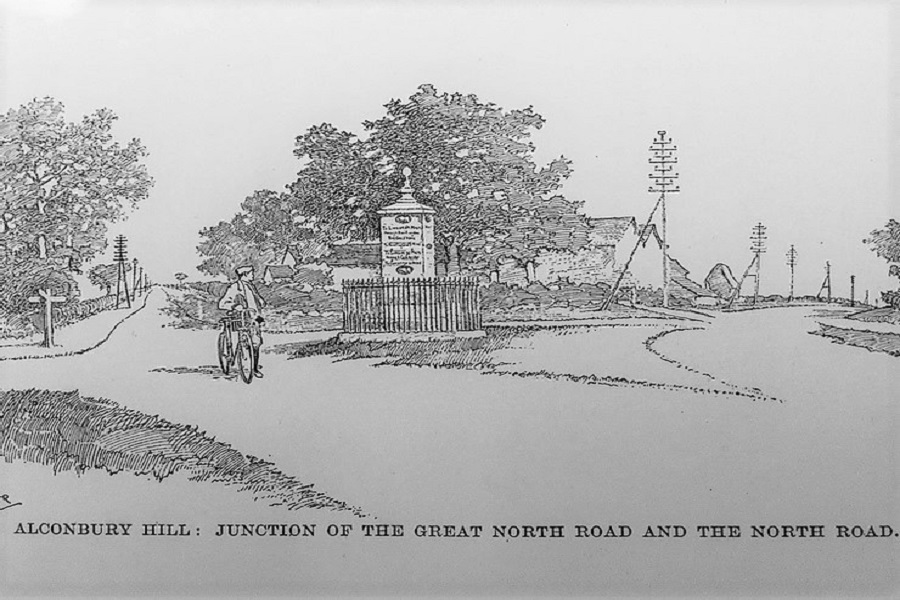Alconbury Junction and the Great North Road
Alconbury has long been an important junction of major routes. It is where the Old North Road and the Great North Road routes from London converged.
The elaborate milestone pictured above indicates 64 miles to London by way of Huntingdon, Royston and Ware; and 4 miles further by the newer route via Biggleswade and Stevenage. A 72-mile option via Cambridge is also indicated.
Somewhat surprisingly, and easily missed, the 18th century signpost is still there, in its original location, on an isolated strip of ground between the old road and the new 8 lane motorway. The 300m marker by the side of the motorway indicates the upcoming branch (left) towards Huntingdon.

Alconbury Hill Milestone. Image Credit – Rex Gibson
The sketch by Harper at top of page is looking south; the Great North Road branches right heading down Vinegar Hill towards Alconbury Weston and Alconbury. The A1 has bypassed these villages since 1964.
About Alconbury Junction
As well as marking the convergence of our two North roads, Alconbury has long been a focus of travel through Britain. Since Roman times, and probably before, it was near here that the routes from the Suffolk coast to the Midlands and the North West crossed the road north.
The modern A14/A1 junction moved south in 2020 towards Brampton but the alliterative sentiments of Frank Goddard are in no way diminished:
This melee merges at the inverted funnel of the Alconbury junction in a calamitous cacophony of cars, coaches, container trucks, cumbersome juggernauts, caravans and their countless consorts in an endless line of chariots, the sight of which on their Ermine Street would have put more fear into the Romans than Boadicea and the Iceni ever did.
The Wheatsheaf Inn, Alconbury Hill
In coaching days there was a large and impressive coaching inn to the east the famous junction of the North roads. According to Harper:
the great Wheatsheaf inn and posting-house, which stood a hundred yards or so away from the junction, used commonly to send out thirty pairs of post-horses a day. This establishment was kept in its prime by John Warsop, who lived long enough to see his business ruined by railways.


The old inn depicted by Charles Dickinson Langley (Image credit: Hinchingbrooke House). And in a 20th century photo (Source unknown).
After the old inn had served its time, a smaller inn with the same name was set up even closer to the junction. This was a landmark for travellers on the Great North Road until it closed in 1997.


To explore the location of the Wheatsheaf Inns and the evolving layout of the roads it is worth a visit to the historic maps hosted by the National Library of Scotland.
More Information about Alconbury Junction
Highways and Byways with Dr John Dunn:


